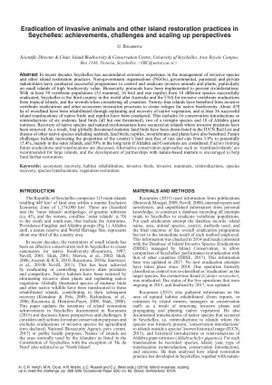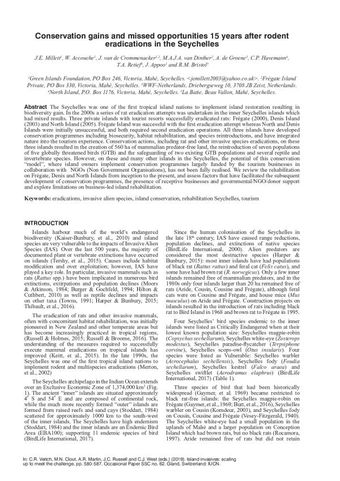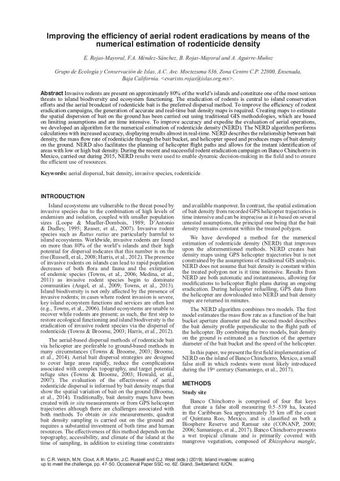Eradication of invasive animals and other island restoration practices in Seychelles: achievements, challenges and scaling up perspectives
- Description:
- In recent decades Seychelles has accumulated extensive experience in the management of invasive species and other island restoration practices. Non-government organisations (NGOs), governmental, parastatal and private stakeholders have conducted successful programmes to control and eradicate invasive animals and plants, particularly on small islands of high biodiversity value. Biosecurity protocols have been implemented to prevent (re)infestations. With at least 50 vertebrate populations (33 mammal, 16 bird and one reptile) from 14 different species successfully eradicated, Seychelles is the third country in the world after Australia and the USA for invasive vertebrate eradications from tropical islands, and the seventh when considering all countries. Twenty-four islands have bene?ted from invasive vertebrate eradications and other ecosystem restoration processes to create refuges for native biodiversity. About 470 ha of woodland have been rehabilitated through replanting and recovery of native vegetation, and at least 36 successful island translocations of native birds and reptiles have been conducted. This includes 16 conservation introductions or reintroductions of six endemic land birds (all but one threatened), two of a terrapin species and 18 of Aldabra giant tortoises. Recovery of native species and natural recolonisations have occurred on islands where invasive predators have been removed. As a result, four globally threatened endemic land birds have been down-listed in the IUCN Red List and dozens of other native species including seabirds, land birds, reptiles, invertebrates and plants have also bene?ted. Future challenges include increasing the proportion of the countrys land area free of rats and cats from 3.9% to potentially 15.4%, mainly in the outer islands, and 50% in the long term if Aldabra and Cosmoledo are considered. Factors limiting future eradications and translocations are discussed. Alternative conservation approaches such as mainland-islands are recommended for large islands, and the development of partnerships with nature-based tourism is encouraged to help fund further restoration.
- Display date:
- 2019
- Collections:
- Secretariat of the Pacific Regional Environment Programme (SPREP)
- Publisher:
- International Union for Nature Conservation (IUCN)
- Content partner:
- Secretariat of the Pacific Regional Environment Programme (SPREP)
- Availability:
- Not specified
-
Copyright status: All rights reservedFind out more about what you are able to do with this itemThis item is all rights reserved, with means you'll have to get permission from Secretariat of the Pacific Regional Environment Programme (SPREP) before using it. For more information, please see our use and reuse page.What can I do with this item?Non-infringing useNZ copyright law does not prevent every use of a copyright work, and this item may be hosted by an international institute or organisation. You should consider what you can and cannot do with a copyright work.No sharingYou may not copy and/or share this item with others without further permission. This includes posting it on your blog, using it in a presentation, or any other public use.No modifyingYou are not allowed to adapt or remix this item into any other works.No commercial useYou may not use this item commercially.
Related items
Welcome and warm Pasifik greetings
The information on this site has been gathered from our content partners.
The names, terms, and labels that we present on the site may contain images or voices of deceased persons and may also reflect the bias, norms, and perspective of the period of time in which they were created. We accept that these may not be appropriate today.
If you have any concerns or questions about an item, please contact us.


